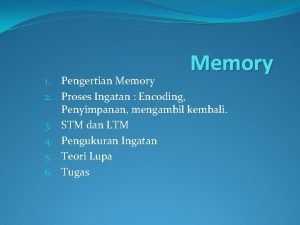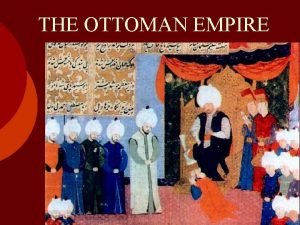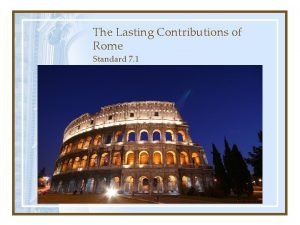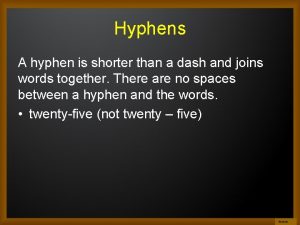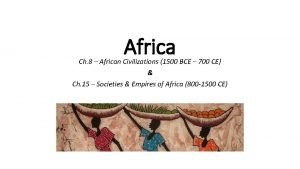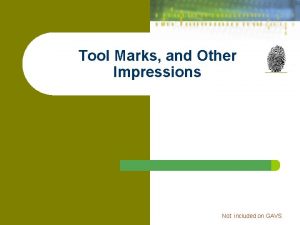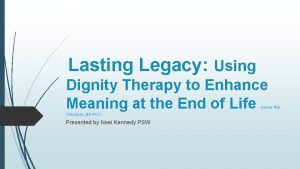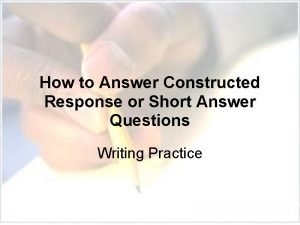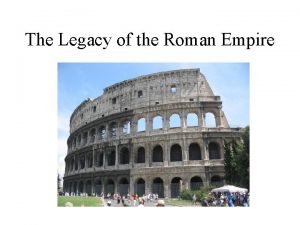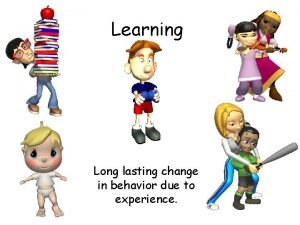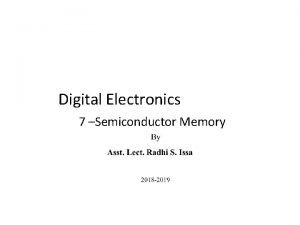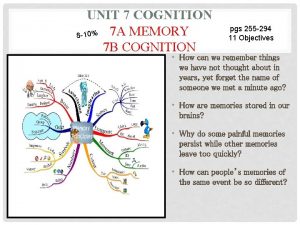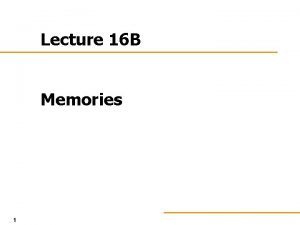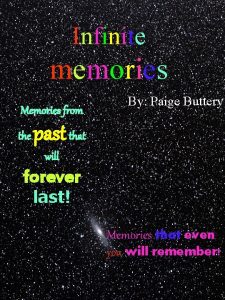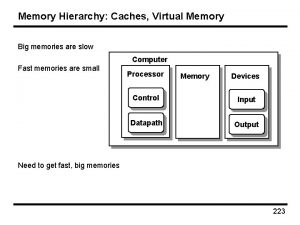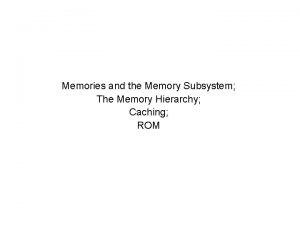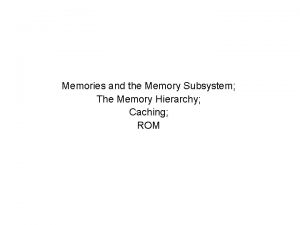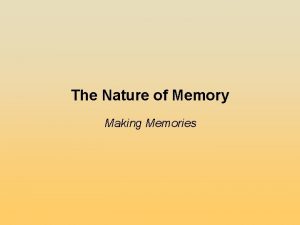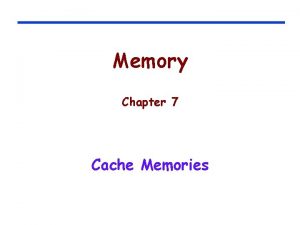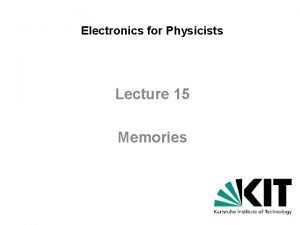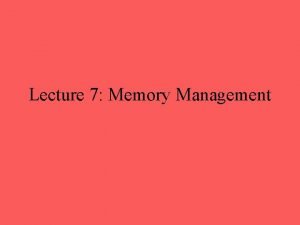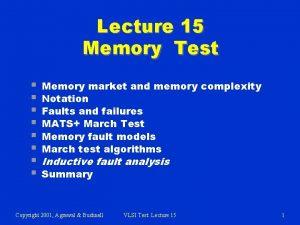Lecture 18 Memory Memories Memory 1 a lasting



















- Slides: 19

Lecture 18: Memory

Memories § Memory 1: a lasting consequence of an event (a broken glass) § Memory 2: a trace of an event that needs recovery with a key (a recollection about a broken glass)

Hysteresis Stim F, L F Curve 1 Curve 2 L An isolated muscle is being stimulated at a constant rate and strength. Muscle force will depend on muscle length. During slow stretching and slow shortening, the muscle will display different dependences F(L). This behavior is called hysteresis.

Memories Declarative (explicit) Facts and events Hippocampus, medial temporal lobe, diencephalon Nondeclarative (implicit) Nonassociative Associative Reflexes Amygdala, cerebellum, BG, cortex Skills, habits

Memory § Habituation: learning not to respond to a stimulus following its multiple presentations (usually, when it is not very meaningful) § Sensitization: learning to respond to smaller magnitudes of a stimulus (usually, if it is very meaningful)

Skill § A motor program? Can it be applied to different effectors? § Are there control functions stored in the brain? In what variables? § A reflex? § Perception-action coupling? How different is it from a reflex?

Learning Mirror Writing

Three Stages § Encoding: putting an event into an internal code § Storage: maintaining the code over time § Retrieval: using a key (intrinsic or extrinsic) to recover the code/event

Short-Term Memory § Encoding: typically an acoustic, visual, or somatosensory code § Storage: limited capacity (7 ± 2 “pieces”); decay; followed by consolidation or loss of memory

A Reverberating Circuit In Out The activity in this simple reverberating circuit will persist until some crucial substances are depleted. Open circles show excitatory synapses.

Consolidation of Memory Input Receptor Long-term memory Central processing Consolidation Short-term memory Effector Output Processing a sensory stimulus may lead to creating a short-term memory trace in parallel with producing an effector (motor) output. Short-term memory can be consolidated into long -term memory.

Conditioning § Classical conditioning: associating a response with a stimulus based on repetitive presentations (e. g. , ringing a bell is associated with getting food); the animal has no initiative § Operant conditioning: searching for an action that leads to a desired consequence; active exploration. Even monosynaptic reflexes can show it (as demonstrated by Jon Wolpaw)!

Conditioning § Classical conditioning: Pavlov’s experiments § The theory of conditioned reflexes starting from inborn reflexes § Towers of silence

Holography Key beam A Photo plate Object Key beam B Image Object beam Holography creates an image (a memory) of an object on a photographic plate with the help of two light beams: the object beam and the key beam (A). One plate can store a number of images using different key beams. If the plate is illuminated by a key beam, an image of the corresponding object will emerge (B).

Synapses as the Site for Memory Pro: § There are phenomena of LTP and LTD (cerebellum, hippocampus) § Where else? Contra: § Repetition without repetition § “Disposable synapses” § Lashley: Each neuron takes part in many memories; each memory is represented all over § LTP: too short, mostly animal studies § Importance of whole-brain (emotion) mechanisms § Eccles: use and disuse of synapses, spinal memory § Spinal memory experiments

Spinal Memory Experiments § Stage 1: extirpation of half of the cerebellum. This leads to asymmetrical monosynaptic reflexes. § Stage 2: spinalization. If enough time elapses between the two surgeries, the asymmetry persists. If not, it disappears. § Cooling experiments: MSRs appear, followed by their asymmetry.

Questions Without Answers § Which of the external events are being remembered? § Which of the brain processes that accompany the events are being fixed in memory? § Can all or only some of the neural elements fix memories? § What are the neural substrates of STM and LTM, and what are the mechanisms of exchange between them? § What happens in memory disorders? What is affected— whole-brain mechanisms, storage, attention, classification, retrieval, etc. ?

Memory Disorders: Amnesia is a partial loss of memory. § Causes: brain injury, stroke, encephalitis, electric shock, etc. § Anterograde: affects the ability to recollect events that occurred after an injury § Retrograde: affects the ability to recollect events that occurred prior to an injury

Memory Disorders Korsakoff’s syndrome: § Chronic alcohol abuse § Defective retrieval § Partial cues or prompts help Alzheimer’s: § Motor skills are not affected § Priming experiments show major defects
 Perbedaan memories dan memory
Perbedaan memories dan memory 01:640:244 lecture notes - lecture 15: plat, idah, farad
01:640:244 lecture notes - lecture 15: plat, idah, farad Longest lasting empire
Longest lasting empire Lasting contributions of rome
Lasting contributions of rome A long lasting paper like material made from reeds
A long lasting paper like material made from reeds Eight year old hyphen
Eight year old hyphen Longest lasting empire
Longest lasting empire The word beatitude means a true and lasting
The word beatitude means a true and lasting What lasting legacies did the aksum kingdom leave
What lasting legacies did the aksum kingdom leave Forensic factor lasting impressions
Forensic factor lasting impressions Dignity therapy questions
Dignity therapy questions Short constructed response rubric
Short constructed response rubric What was the legacy of the roman empire
What was the legacy of the roman empire Lasting impacts of the new deal
Lasting impacts of the new deal Adequate service level
Adequate service level An event that leads to lasting change
An event that leads to lasting change Shape memory alloys lecture notes
Shape memory alloys lecture notes Memory in digital electronics
Memory in digital electronics What effortful processing methods aid in forming memories?
What effortful processing methods aid in forming memories? N the zone photography
N the zone photography
